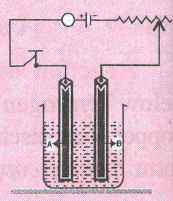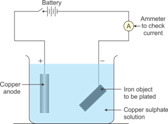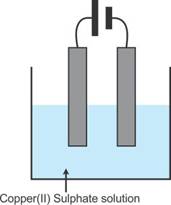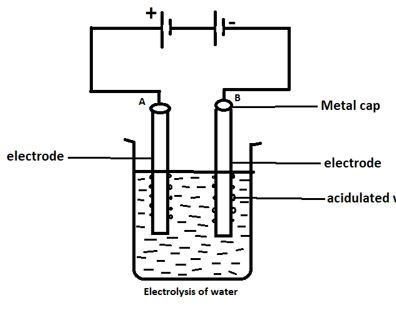Electrolysis ICSE Class-10 Concise Chemistry Selina Solutions Chapter-6. We Provide Step by Step Answer of Intext 1 and 2, Exercise-6 , Miscellaneous and Previous Year Questions of Exercise-6 Electrolysis ICSE Class-10 Concise . Visit official Website CISCE for detail information about ICSE Board Class-10.
Electrolysis ICSE Class-10 Concise Chemistry Selina Solutions Chapter-6
| Board | ICSE |
| Publications | Selina Publishers PVT LTD |
| Subject | Concise Chemistry |
| Class | 10th |
| writer | Dr SP Singh |
| Chapter-6 | Electrolysis |
| Topics | Solutions of Intext -1 , 2 and Exercise-6 Questions |
| Edition | 2021-2022 |
-: Select Topics :-
Intext Questions , Electrolysis ICSE Class-10 Concise
Page-107
Question 1
Fill in the blanks:
(a) Powdered sodium chloride (common salt) does not conduct an electric current, but it does so when ____ or when _____.
(b) Molten lead bromide conducts electricity. It is called an____. It is composed of lead ____ and bromide _____. The lead ions are ____charged and are called_____. The bromide ____ are _____ charged and are called ______.
(c) Substances which conduct electricity in the solid state are generally ______.
(d) The electron releasing tendency of zinc is _____than that of copper.
(e) A solution of HCl gas in water conducts electricity because _____, but a solution of HCl gas in toluene does not conduct an electric current because_____.
(f) Pure water consists entirely of ………….. (ions/molecules).
(g) We can expect that pure water …………… (will/will not) normally conduct electricity.
(h) Electrolysis is the passage of……………. (electricity/electrons) through a liquid or a solution accompanied by a ………….. (physical/chemical) change.
Answer 1
(a) Powdered sodium chloride (common salt) does not conduct an electric current, but it does so when dissolved in water or when melted.
(b) Molten lead bromide conducts electricity .It is called an electrolyte. It is composed of lead ions and bromide ions. The lead ions are positively charged and are called cations. The bromide ions are negatively charged and are called anions.
(c) Substances which conduct electricity in the solid state are generally metals.
(d) The electron releasing tendency of zinc is more than that of copper.
(e) A solution of HCl gas in water conducts electricity because it ionizes , but a solution of HCl gas in toluene does not conduct an electric current because it does not ionize in toluene.
(f) Pure water consists entirely of molecules.
(g) We can expect that pure water will not normally conduct electricity.
(h) Electrolysis is the passage of electricity through a liquid or a solution accompanied by a chemical change.
Question 2
Define the following terms:
(a) Electrolysis
(b) Non-electrolyte
(c) Cation and an anion
(d) Weak electrolyte
Answer 2
(a) Electrolysis: It is the process of decomposition of a chemical compound in aqueous solutions or in molten state accompanied by a chemical change using direct electric current.
(b) Non-electrolyte: It is a compound which neither in solution nor in the molten state allows an electric current to pass through it.
(c) Cation and anion: Atoms which carry positive charge are called cations.
Atoms which carry negative charge are called anions.
(d) Weak electrolyte: Electrolytes which allow small amount of electricity to flow through them and are partially dissociated in fused or aqueous solution are called weak electrolyte.
Question 3
What is the difference between:
(a) Modern explanation and Arrhenius explanation for the theory of electrolysis
(b) Electrolytic dissociation and ionization
(c) A cation and an anion
(d) Electrolytic dissociation and thermal dissociation
(e) Strong electrolyte and weak electrolyte
Answer 3
(a) Difference between Modern explanation and Arrhenius explanation for the theory of electrolysis:
Arrhenius considered that water ionizes electrolytes but Modern theory explained that electrolytes are ionic even in solid state and their ions are held by strong electrostatic forces which make them immobile. Water renders these ions mobility by breaking the electrostatic forces.
(b) Difference between electrolytic dissociation and ionization :
| Ionisation | Dissociation |
| 1. Formation of positively or negatively charged ions from molecules which are not initially in the ionic state. | 1. Separation of ions which are already present in an ionic compound. |
| 2. Polar covalent compounds show ionization. e.g. HCl, H2CO3, NH4OH etc. | 1. Electrovalent compounds show dissociation. e.g. Potassium chloride , lead bromide, etc. |
(c) difference between A cation and anion:
| Cation | Anion |
| 1. Are positively charged ions. | Are negatively charged ions. |
| 2. Migrate to cathode during electrolysis. | Migrate to anode during electrolysis. |
| 3. Gain electron from the cathode and get reduced to become a neutral atom. | Lose electrons to the anode and get oxidized to become a neutral atom. |
(d) difference between Electrolytic dissociation and thermal dissociation:
Electrolytic dissociation is the dissociation of an electrovalent compound into ions in the fused state or in aqueous solution state.
Thermal dissociation: Reversible breakdown of a chemical compound into simpler substances by heating it. The splitting of ammonium chloride into ammonia and hydrogen chloride is an example. On cooling, they recombine to form the salt.
(e) difference between Strong Electrolytes and Weak Electrolytes.
| Strong Electrolytes | Weak Electrolytes |
| Electrolytes which allow a large amount of electricity to flow through them. | Electrolytes which allow small amounts of electricity to flow through them. |
| These are good conductors of electricity. | These are poor conductors of electricity. |
| These almost completely dissociate in the fused or aqueous solution state. | These are partially dissociated in the fused or aqueous solution state. |
| These solutions contain only free mobile ions. | These solutions contain ions as well as molecules. |
Question 4
Name:
(a) A salt which is a weak electrolyte
(b) A base which is a weak electrolyte
(c) An inert electrode and an active electrode
(d) A positively charged non-metallic ion
(e) The electrode at which reduction occurs
(f) A non-metallic element which is a conductor of electricity
Answer 4
(a) Sodium carbonate
(b) NH4OH
(c) An inert electrode: graphite and Active electrode: silver
(d) H+
(e) Electrode is cathode
(f) Graphite
Question 5
Electrolysis is a redox process. Explain.
Answer 5
Electrolysis is a redox process. The reaction at the cathode involves reduction of cations as they gain of electrons while the reaction at anode involves oxidation of anions as they loss of electrons to become neutral.
Example: Dissociation of sodium chloride during electrolysis.
NaCl Na+ + Cl–
Cathode : Na+ + e- Na(reduction)
Cl– – e– Cl(oxidation)
Cl + Cl Cl2
Overall reaction :2NaCl 2Na + Cl2
Question 6
Classify the following substances under three headings:
(a) strong electrolytes
(b) weak electrolytes
(c) non-electrolytes
Acetic acid, ammonium chloride, ammonium hydroxide, carbon tetrachloride, dilute hydrochloric acid, sodium acetate, dilute sulphuric acid.
Answer 6
(a) dilute hydrochloric acid, dilute sulphuric acid, sodium acetate
(b) acetic acid, ammonium hydroxide
(c) carbon tetrachloride
Question 7
Explain why:
(a) Cu, though a good conductor of electricity, is a non-electrolyte.
(b) Solid sodium chloride does not allow electricity to pass through.
Answer 7
(a) Copper metal is a solid and has no mobile ions, whereas an electrolyte should dissociate into oppositely charged ions to conduct the electric current.
(b) In solid sodium chloride, Na+and Cl– ions are not mobile to conduct the electric current.
Question 8
Choose A, B, C or D to match the descriptions
(i) to (v) below. Some letters may be repeated.
(A) non-electrolyte (B) strong electrolyte (C) weak electrolyte (D) metallic conductor
(i) Molten ionic compound
(ii) Carbon tetrachloride
(iii). An aluminium wire
(iv) A solution containing solvent molecules, solute molecules and ions formed by the dissociation of solute molecules.
(v) A sugar solution with sugar molecules and water molecules.
Answer 8
(i) Molten ionic compound – strong electrolyte
(ii) Carbon tetrachloride – non-electrolyte
(iii). Aluminium wire – metallic conductor
(iv) A solution containing solvent molecules, solute molecules and ions formed by the dissociation of solute molecules. – weak electrolyte
(v) A sugar solution with sugar molecules and water molecules. – non-electrolyte
Question-9
An electrolyte which complete dissociate into ions is:
(A) Alcohol (B) Carbonic Acid (C) sucrose (D) Sodium Hydroxide
Answer- 9
Option (D) Sodium Hydroxide is correct
Intext -2, Electrolysis Selina Solutions for ICSE Class-10 Concise Chemistry
Page-113
Question 1
Name two substances in each case:
(a) Contain only molecules
(b) Contain only ions
(c) Contain ions as well as molecules
Answer 1
(a) Glucose, Kerosene
(b) NaCl and NaOH
(c) CH3COOH and NH4OH
Question 2
Select the ion in each case that would get selectively discharged from the aqueous mixture of the ions listed below:

Answer 2
(a) OH–
(b)Ag+
Question 3
(a) Among Zn and Cu, which would occur more readily in nature as metal and which as ion?
(b) Why cannot we store AgNO3 solution in copper vessel?
(c) Out of Cu and Ag, which is more active?
Answer 3
(a) Zn occurs readily as ion whereas Cu occurs more readily as metal in nature.
(b) Copper is above silver in the electrochemical series and is thus more reactive than silver. So, copper displaces silver from silver nitrate. Hence, we cannot store AgNO3 solution in copper vessel.
Cu +AgNO3 Cu(NO3)2 + 2Ag
(c) Copper is more active than Ag.
Question 4
(a) How would you change a metal like Cu into ions?
(b) How would you change Cu2+ ions to Cu?
Answer 4
(a) By treating its salt with a more reactive metal.
(b) By supplying two electrons to Cu+2
Cu+2 + 2e–Cu
Question 5
A solution of caustic soda (NaOH) in water or when fused, conducts an electric current. What is the similarity in these two cases?
Answer 5
In the aqueous state, the slightly negatively charged oxygen atoms of the polar water molecule exerts a pull on the positively charged sodium ions. A similar pull is exerted by the slightly charged hydrogen atoms of the water on the negatively charged chloride ions. Thus the ions become free in solution. These free ions conduct electricity.
In the molten state, the high temperatures required to melt the solid weakens the bond between the particles and the ions are set free.
Question 6
During electrolysis of an aqueous solution of sulphuric acid between platinum electrodes, two types of anions migrate towards the anode but only one of them is discharged.
(a) Name the two anions.
(b) Name the main product of the discharge of anion at the anode and write the anode reaction.
(c) Name the product at the cathode and write the reaction.
(d) Do you notice any change in colour. State why?
(e) Why this electrolysis is considered as an example of catalysis.
Answer 6
(a) Two anions are![]() and OH–.
and OH–.
(b) OH– is discharged at anode and the main product of the discharge of OH– is O2
Reaction is :
OH– ![]() OH +e–
OH +e–
4OH ![]() 2H2O + O2
2H2O + O2
(c) The product formed at cathode is hydrogen. The reaction is :
H+ + e– ![]() H
H
H + H![]() H2
H2
(d) No change in colour is observed.
(e) Dilute sulphuric acid catalyse the dissociation of water molecules into ions, hence electrolysis of acidified water is considered as an example of catalysis.
Question 7
Copper sulphate solution is electrolysed using a platinum anode. Study the diagram given alongside and answer the following questions:\

(a) Give the names of the electrodes A and B.
(b) Which electrode is the oxidising electrode?
Answer 7
(a) A = Platinum anode, B = Platinum or copper cathode
(b) A = Platinum anode
Question 8
To carry out the so-called ‘electrolysis of water’, sulphuric acid is added to water. How does the addition of sulphuric acid produce a conducting solution?
Answer 8
The addition of sulphuric acid causes dissociation of water into H+ ions and OH– ions.
Question 9
Choosing only words from the following list, write down the appropriate words to fill in the blanks (i) to (v) below: Anions , anode, cathode, cations , electrode, electrolyte, nickel , voltameter.
The electroplating of an article with nickel requires an (i) ____ which must be solution containing (ii) ____ ions. The article to be plated is placed as the (iii) ____ of the cell in which the plating is carried out. The (iv) ____ of the cell is made from pure nickel. The ions that are attracted to the negative electrode and discharged are called (v) _____.
(b) When a molten ionic compound is electrolysed, the metal is always formed at …………… and the non-metal is formed at …………..
(c) Electrolysis of acidulated water is an example of ………… (Reduction/ oxidation/ redox reaction/synthesis) (2018)
Answer 9
(a) Electrolyte
(b) Nickel
(c) Cathode
(d) Anode
(e) Cations
(b) cathode, anode
(c) Electrolysis of acidulated water is an example of redox reaction.
Question 10
Explain the following :
(a) A solution of cane sugar does not conduct electricity, but a solution of sodium chloride is a good conductor,
(b) Hydrochloric acid is a good conductor of electricity.
(c) During the electrolysis of an aqueous solution of NaCl, hydrogen ion is reduced at the cathode and not the sodium ion though both Na+ and H+ ions are present in the solution.
(d) On electrolysis of dilute copper (II) sulphate solution, copper is deposited at the cathode but hydrogen gas evolves there. Explain why.
(e) When a dilute aqueous solution of sodium chloride is electrolysed between platinum electrodes, hydrogen gas is evolved at the cathode but metallic sodium is not deposited. Why?
(f) Zinc can produce hydrogen on reacting with acids but copper cannot. Explain.
Answer 10
(a) Cane sugar is a compound which does not have ions even in solution and contains only molecules. Hence, it does not conduct electricity. On the other hand, sodium chloride solution contains free mobile ions and allows electric current to pass through it. This makes it a good conductor of electricity.
(b) Hydrochloric acid is a strong electrolyte and dissociates completely in aqueous solution. The solution contains free mobile ions which allow electric current to pass through it. Hence, hydrochloric acid is a good conductor of electricity.
(c) Hydrogen is placed lower in the electrochemical series and sodium is placed at a higher position. This is because H+ ions are discharged more easily at the cathode than Na+ during electrolysis and gains electrons more easily.
Therefore, H+ ion is reduced at the cathode and not Na+ ion.
(d)Copper is placed below hydrogen in the activity series. Cu2+ on reduction is discharged as metallic copper in preference to hydrogen.
(e) Since hydrogen is much below sodium in the activity series, hydrogen is discharged at the cathode in preference to sodium.
(f)Zinc is more reactive than hydrogen, so it displaces hydrogen from acids, but copper is less reactive than hydrogen, so it does not liberate hydrogen from acids.
Exercise – 6 Electrolysis ICSE Class-10 Concise Chemistry Selina Solutions
Page-117
Question 1
Give reasons for the following:
(a) Electrolysis of molten lead bromide is considered to be a reaction in which oxidation and reduction go side by side i.e, a redox reaction.
(b) The blue colour of aqueous copper sulphate fades when it is electrolyzed using platinum electrodes.
(c) Lead bromide undergoes electrolytic dissociation in the molten state but is a non-electrolyte in the solid state.
(d) Aluminium is extracted from its oxide by electrolytic reduction and not by conventional reducing agents.
(e) The ratio of hydrogen and oxygen formed at the cathode and anode is 2:1 by volume.
(f) In the electrolysis of acidified water, dilute sulphuric acid is preferred to dilute nitric acid for acidification.
(g) Ammonia is unionized in the gaseous state but in the aqueous solution, it is a weak electrolyte.
(h) A graphite anode is preferred to other inert electrode during electrolysis of fused lead bromide.
(i) For electroplating with silver, silver nitrate is not used as electrolyte.
(j) Carbon tetrachloride is a liquid but does not conduct electricity.
(k) Potassium is not extracted by electrolysis of its aqueous salt solution.
Answer 1
(a) During electrolysis of lead bromide,
there is loss of electrons at anode by bromine and gain of electrons at cathode by lead. Thus oxidation and reduction go side by side. Therefore, it is a redox reaction.
![]()
(b) The blue colour of copper ions fades
due to decrease in Cu+2 ions and finally the solution becomes colourless as soon as Cu+2 ions are finished.
(c) Lead bromide dissociate into ions in the molten state
whereas it does not dissociate in solid state. The ions become free when lead bromide is in molten state but in the solid state the ions are not free since they are packed tightly together due to electrostatic force between them. Therefore, lead bromide undergoes electrolytic dissociation in the molten state.
(d) Aluminium has great affinity towards oxygen,
so it is not reduced by reducing agent. Therefore it is extracted from its oxide by electrolytic reduction.
(e) As per electrolytic reactions, 4H+1 are needed at cathode and 4OH– at the anode and two molecules of water are produced at the anode. Hence for every two molecules of water, two molecules of hydrogen and one molecule of oxygen are liberated at the cathode and anode respectively.
![]()
(f) This is because HNO3 is volatile.
(g) Ammonia is a covalent compound.
Therefore, it is unionized in the gaseous state but in the aqueous solution it gives NH4OH which is a weak electrolyte and dissociates into ions.
(h) Graphite is unaffected by the bromine vapours.
(i) Silver nitrate is not used as electrolyte for electroplating with silver because the deposition of silver will be very fast and hence not very smooth and uniform.
(j) Carbon tetrachloride is a liquid and does not conduct electricity because it is a covalent compound and there are no free ions present and contain only molecules.
(k) Potassium is not extracted from its aqueous salt solution by electrolysis as it can react with water.
Question 2
(a)Copy and complete the following table which refers to two practical applications of electrolysis
| Anode | Electrolyte | Cathode | ||
| Silver plating of spoon | Solution of potassium argentocyanide | |||
| Purification of copper | ||||
(b) write equation of reaction taking place at anode for Q-2 (a)
Answer 2
(a)
| Anode | Electrolyte | Cathode | |
| Silver plating of spoon | Plate of pure clean silver | Solution of potassium
argento cyanide |
Article to be electroplated |
| Purification of copper | Impure copper | Solution of copper sulphate and dilute sulphuric acid | Thin strip of pure copper |
(b)
Reaction at anode
\( Ag- e^{-}\rightarrow Ag^{+} \)
(2015)
Question 3
(a) Draw a labeled diagram to show how iron is electroplated with copper.
(b) Which solution is preferred as electrolyte, CuSO4 or FeSO4?
(c) Describe what happens to the iron object and the copper rod.
Answer 3
(a)

(b) CuSO4 is preferred as an electrolyte.
(c) The copper anode continuously dissolves as ions in solution and is replaced periodically. The electrolyte dissociates into Cu+2 ions which migrate towards the iron object taken as the cathode and are deposited as neutral copper atoms on the cathode.
Electrolyte: Aqueous solution of nickel sulphate
Dissociation: CuSO4 ![]() Cu2+ + SO42-
Cu2+ + SO42-
H2O ![]() H+ + OH–
H+ + OH–
Electrodes:
Cathode: Article to be electroplated
Anode: Block of pure copper
Electrode reactions:
Reaction at cathode: Cu2+ + 2e–→ Cu (deposited)
Reaction at anode: Cu – 2e–→ Cu2+
Question 4
Element X is a metal with a valency 2. Element Y is a non-metal with a valency 3.
(a) Write equations to show how X and Y form ions?
(b) If Y is a diatomic gas, write the equation for the direct combination of X and Y to form a compound. (2015)
(c) If the compound formed between X and Y is melted and an electric current passed through the molten compound, the element X will be obtained at the _____ and Y at the _________of the electrolytic cell.(Provide the missing words)
Answer 4
(a) X ![]() X2+ +2e–,Y + 3e
X2+ +2e–,Y + 3e ![]() Y3-
Y3-
(b) Y2 + 3X ![]() X3Y2
X3Y2
(c) Cathode, Anode
Question 5
Write two applications of electrolysis in which the anode diminishes in mass.
Answer 5
- Electroplating of metals
- Electrorefining of metals
Question 6
(a) What kind of particles will be found in a liquid compound which is a non- electrolyte?
(b) If HX is a weak acid, what particles will be present in its dilute solution apart from those of water?
(c) Cations are formed by ____ (loss/gain) of electrons and anions are formed by _________(loss/gain) of electrons. (Choose the correct word to fill in blank)
(d) What ions must be present in a solution used for electroplating a particular metal?
Answer 6
(a) Non-electrolyte contains molecules.
(b) Molecules of HX and H+ and X– ions.
(c) Loss
(d) The electrolyte used for the purpose must contain the ions of metal which is to be electroplated on the article.
Question 7
A strip of copper is placed in four different colourless salt solutions. They are KNO3, AgNO3, Zn(NO3)2 and Ca(NO3)2. Which one of the solutions will finally turn blue?
Answer 7
AgNO3 solution finally turn blue
Previous Year Question of Chapter- 6 Electrolysis ICSE Class-10 Concise Chemistry Selina Solutions
Page-117
Question 2008
(a) Here is an electrode reaction :
Cu  Cu+2 +2e–
Cu+2 +2e–
At which electrode (anode or cathode) would such a reaction take place? Is this an example of oxidation or reduction?
(b) A solution contains magnesium ions (Mg+2), iron (II) ions (Fe+2) and copper ions (Cu+2).On passing an electric current through this solution, which ions will be first to be discharged at the cathode? Write the equation for the cathode reaction.
(c) Why is carbon tetrachloride, which is a liquid a non-electrolyte?
(d) During the electrolysis of molten lead bromide, which of the following takes place?
A. Bromine is released at the cathode
B. Lead is deposited at the anode
C. Bromine ions gain electrons
D. Lead is deposited at the cathode
Answer 2008
(a) The reaction takes place at anode. This is an example of oxidation.
(b) Cu+2 will discharge easily at cathode.
Reaction at cathode:
Cu+2 +2e– ![]() Cu
Cu
(c) Carbon tetrachloride is a non-electrolyte because it is a covalent compound. It does not ionize and hence do not conduct electricity.
(D) During the electrolysis of molten lead bromide. Lead is deposited at cathode.
Page-118
Question 2009
Select the correct answer:
The aqueous solution of the compound which contains both ions and molecules is
A. H2SO4
B HCl
C. HNO3
D. CH3COOH
(b) Correct the following statement:
Lead bromide conducts electricity.
(c) A metal article is to be electroplated with silver. The electrolyte selected is sodium argentocyanide.
(i) What kind of salt is sodium argentocyanide?
(ii) Why is it preferred to silver nitrate as an electrolyte?
(iii) State one condition to ensure that the deposit is smooth, firm and long lasting.
(iv) Write the reaction taking place at the cathode.
(v) Write the reaction taking place at the anode.
(d) Aqueous solution of nickel sulphate contains Ni2+ and SO42- ions.
(i) Which ion moves towards the cathode?
(ii) What is the product at the anode?
Answer 2009
(a) CH3COOH
(b) Molten lead bromide conducts electricity.
(c) (i) Complex salt
(ii) On using silver nitrate, the deposition of silver on the cathode is very fast and hence not very smooth and uniform because it is a strong electrolyte.
(iii) A long current for a longer time should be used.
(iv) Ag++ e– → Ag
(v) Ag – e– → Ag+
(d)
(i) Ni2+ ions
(ii) Oxygen gas, when an inert electrode is used.
Question 2010
(a) Select the correct answer: A compound which during electrolysis in its molten state liberates a reddish brown gas at the anode.
(i) Sodium chloride
(ii) Copper [II] oxide
(iii) Copper [II] sulphate
(iv) Lead [II] bromide
(b) During electroplating of an article with nickel,
(i) Name
A.. The electrolyte
B. The cathode
C. The anode
(ii) Give the reaction of electrolysis at
A. The cathode
B The anode
(c) A, B and C are three electrolytic cells connected in different circuits. Cell ‘A’ contains NaCl solution. And the bulb in the circuit glows brightly when the circuit is completed. Cell ‘B’ contains acetic acid and the bulb glows dimly. Cell ‘C’ contains sugar solution, and the bulb does not glow. Give reason for each observation.
Answer 2010
(a) Lead [II] bromide
(b) (i)
A. Aqueous solution of nickel sulphate with few drops of dil.sulphuricacid
B. Article (e.g. key chain)
C. Pure nickel
(ii) A. Ni2++ 2e– →Ni
B. Ni→ Ni2+ + 2e–
(c) Cell A contains sodium chloride solution which is a strong electrolyte and contains only ions. So, it conducts electricity and the bulb glows brightly.
Cell B contains both ions and molecules. So, there are few ions to conduct electricity and the bulb glows dimly.
Cell C contains sugar solution which is a non-electrolyte and does not contain ions. So, it is a bad conductor of electricity and the bulb does not glow.
Question 2011
(a) Give reason: The electrolysis of acidulated water is considered to be an example of catalysis.
(b) During the electrolysis of copper [H] sulphate solution using platinum as a cathode and carbon as an anode,
(i) State what you observe at the cathode and at the anode.
(ii) State the change noticed in the electrolyte.
(iii) Write the reactions at the cathode and at the anode.
(c) Differentiate between electrical conductivity of copper sulphate solution and that of copper metal.
Answer 2011
(a) Dilute sulphuric acid catalyses dissociation, so electrolysis of acidified water is considered an example of catalysis.
(b)
(i) Red shiny metal deposits at the cathode.
(ii) The colour of the electrolytes changes gradually from blue to colourless.
(iii) At the cathode:
Cu2+ + 2e– → Cu
Reaction at the anode:
OH– → OH + e–
4OH → 2H2O + O2
(c) Differentiate between electrical conductivity of copper sulphate solution and that of copper metal.
| Copper sulphate solution | Copper metal |
| Conduction of electricity is due to the flow of ions. | Conduction of electricity is due to the flow of electrons. |
| It is an aqueous solution of an ionic compound. | this is a metal in the solid state. |
| It undergoes a chemical change. | It remains unchanged chemically. |
Question 2012
(a) Identify the weak electrolyte from the following:
(i) Sodium chloride solution
(ii) Dilute hydrochloric acid
(iii) Dilute sulphuric acid
(iv) Aq. acetic acid
(b) Match the following in Column A with the correct
answer from the choices given in Column B:
| Column A | Column B |
| 1. Ammonium hydroxide solution | (i) Contains only ions |
| 2. Dilute hydrochloric acid | (ii) Contains only molecules |
| 3. Carbon tetrachloride | (iii) Contains ions and molecules |
(c) Give reason: An aqueous solution of sodium chloride conducts electricity.
(d) Select the correct answer from the list in brackets:
(i) An aqueous electrolyte consists of the ions mentioned in the list. The ion which could be discharged most readily during electrolysis… [Fe2+, Cu2+, Pb2+, H1+]
(ii) The metallic electrode which does not take part in an electrolytic reaction… [Cu, Ag, Pt, Ni]
(iii) . The ion which is discharged at the anode during the electrolysis of copper sulphate solution using copper electrodes as anode and cathode… [Cu2+, OH1-, SO42-, H1+]
(iv) When dilute sodium chloride is electrolysed using graphite electrodes, the cation which is discharged at the cathode most readily… [Na1+, OH1-, H1+, Cl1-]
(v) During silver plating of an article using potassium argentocyanide as an electrolyte, the anode material should be… [Cu, Ag, Pt, Fe]
Answer 2012
(a) Aq. acetic acid
(b) Ammonium hydroxide solution – Contains ions and molecules
Dilute hydrochloric acid – Contains only ions
Carbon tetrachloride – Contains only molecules
(c) An aqueous solution of sodium chloride contains free sodium ions and chloride ions. It thus allows a large amount of electricity to flow through and the bulb glows brightly.
(d) (i) Cu2+
(ii) Pt
(iii). Cu2+
(iv) H+
(v) Ag
Page-119
Question 2013
(a) State one appropriate observation for:
Electricity is passed through molten lead bromide.
(b)State which of these will act as a non-electrolyte:
(i) Liquid carbon tetrachloride
(ii) Acetic acid
(iii) . Sodium hydroxide aqueous solution
(iv) Potassium chloride aqueous solution
(c) Copper sulphate soln. is electrolysed using copper electrodes.

(i) Which electrode to your left or right is known as the oxidising electrode and why?
(ii) Write the equation representing the reaction that occurs.
(iii) . State two appropriate observations for the above electrolysis reaction.
(d) Identify: A gas which does not conduct electricity in the liquid state but conducts electricity when dissolved in water.
Answer 2013
(a) Dark reddish brown fumes of bromine evolve at the anode and greyish white metal lead is formed on the cathode.
(b) i. Liquid carbon tetrachloride
(c)
(i) The right electrode is the anode and oxidising electrode. Cu → Cu2+ + 2e– losing electrode.
(ii) Reaction at the anode: Cu → Cu2+ + 2e–
Reaction at the cathode: Cu2+ + 2e–→ Cu
(iii) The anode dissolves and anode mud containing precious metal is recovered.
(d) Hydrogen chloride
Question 2014
(a) The observation seen when fused lead bromide is electrolysed is
(i) A silver grey deposit at anode and a reddish brown deposit at cathode.
(ii) A silver grey deposit at cathode and a reddish brown deposit at anode.
(iii) A silver grey deposit at cathode and reddish brown fumes at anode.
(iv) Silver grey fumes at anode and reddish brown fumes at cathode.
(b) During electroplating an article with silver, the electrolyte used is
(i) Silver nitrate solution
(ii) Silver cyanide solution
(iii). Sodium argentocyanide solution
(iv) Nickel sulphate solution
(c) Give one word or phrase for:
Electrolytic deposition of a superior metal on a baser metal
(d) State your observation seen: At the cathode when acidified aqueous copper sulphate solution is electrolysed with copper electrodes.
(e) State which electrode: anode or cathode is the oxidising electrode. Give a reason for the same.
(f) Name the kind of particles present in
(i) Sodium hydroxide solution
(ii) Carbonic acid
(iii) . Sugar solution
(g) M2O is the oxide of a metal ‘M’ which is above hydrogen in the activity series. M2O when dissolved in water forms the corresponding hydroxide which is a good conductor of electricity.
(i) State the reaction taking place at the cathode
(ii) Name the product at the anode
Answer 2014
(a) iii. A silver grey deposit at cathode and reddish brown fumes at anode.
(b) iii. Sodium argentocyanide solution
(c) Galvanisation
(d) Acidified aqueous copper sulphate solution is electrolysed with copper electrodes by electrolysis.
The electrolysis of an aqueous solution of copper sulphate using copper electrodes (i.e. using active electrodes) results in transfer of copper metal from the anode to the cathode during electrolysis. The copper sulphate is ionised in the aqueous solution.
Copper sulphate solution is ionised by the following chemical equation:
CuSO4 → Cu2+ + SO42-
The positively charged copper ions migrate to the cathode, where each gains two electrons to become copper atoms which are deposited on the cathode.
Cu2+ + 2e–→ Cu
Hence, the colour of copper sulphate changes from
blue to colourless.
(e) Cathode (Reducing electrode): At the cathode, the cations gain electrons to form neutral atoms. As electrons are gained, the ion is said to be reduced. Anode (Oxidising electrode): At the anode, the anions lose electrons to form neutral atoms. As electrons are lost, the ion is said to be oxidised.
(f)
(i) Positive sodium ions and negative hydroxide ions
(ii) Hydrogen ions and carbonate ions
(iii) Glucose, fructose and galactose
(f)
(i) At the cathode: M+ + 1e–→ M
(ii) At the anode: Oxygen gas
Question 2015
(a) State the observation at the anode when aqueous copper sulphate solution is electrolysed using copper electrodes.
(b) During electrolysis of molten lead bromide, graphite anode is preferred to other electrodes. Give reason
(c) Electrolysis of molten lead bromide is considered to be a redox reaction. Give reason.
Answer 2015
(a) Copper anode itself ionises to give Cu2+ ions.
Cu – 2e– → Cu2+
(b) During the electrolysis of molten lead bromide and a graphite anode is preferred because graphite remains unaffected by the reactive bromine vapours which are released at the anode.
(c) In the electrolysis of molten lead bromide, the following reactions take place:
At the cathode: Pb2+ (l) + 2e– → Pb(l)
At the anode: 2Br– (l) → Br2 (g) + 2e–
Lead (II) ions (Pb2+) are attracted to the negative electrode, and the Pb2+ ions are forced to accept two electrons. Pb2+ ions are reduced. Bromide ions (Br–) are attracted to the positive electrode, and the bromide ions are forced to give away their extra electron to form bromine atoms. Thus, bromide ions are oxidised. So, electrolysis of molten lead bromide is a redox reaction.
Question 2016
Give reasons why :
(a) Sodium Chloride will conduct electricity only in fused or aqueous solution state.
(b) the electroplating of an article with silver, the electrolyte sodium argentocyanide solution is preferred over silver nitrate solution.
(c) Although copper is a good conductor of electricity, it is a non-electrolyte
Answer 2016
(a) Electrostatic forces of attraction between ions in the solid state are very strong. These forces weaken in the fused or solution state. Hence, ions become mobile.
(b) silver nitrate solution is used directly instead of double cyanide of silver and sodium, silver will deposit very fast and its deposition will not be smooth and uniform.
(c) Copper has no mobile electrons in the solid state and an electrolyte should dissociate into oppositely charged ions to conduct electricity.
Hence, copper is a non-electrolyte.
–: end of Electrolysis Concise Selina Chemistry Solutions :-
Return to:- Concise Selina Solutions for ICSE Chemistry Class-10
Thanks
Please Share with Your ICSE Friends




